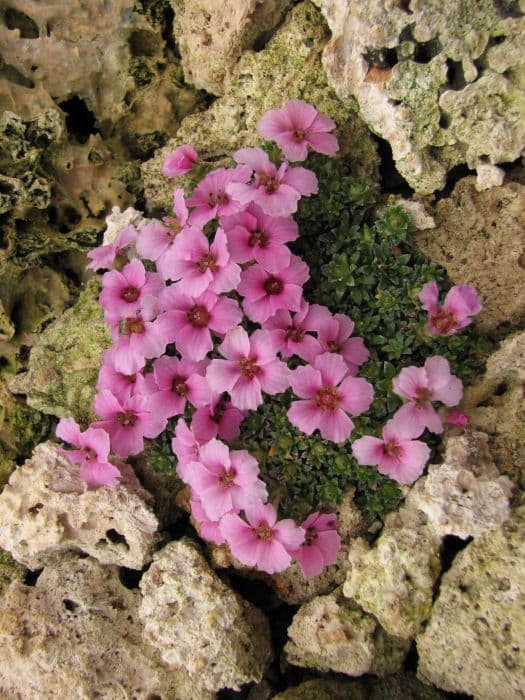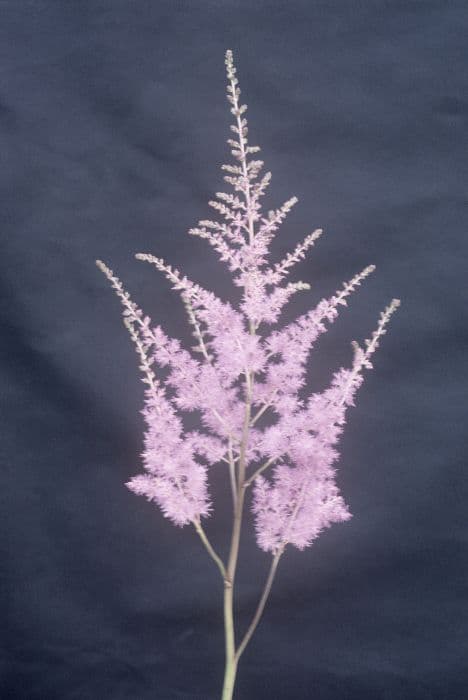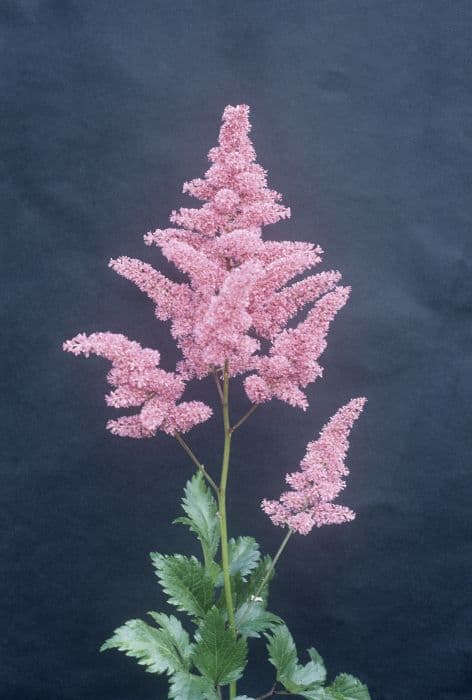False London Pride Saxifraga 'Miluj Mne' (× poluanglica) (7)

ABOUT
The Saxifraga 'Miluj Mne', commonly known as the Saxifrage, is a visually captivating species. Its foliage is typically lush and forms attractive mounds or tufts. The leaves of the Saxifrage are often rich green in color and can sometimes bear a silvery sheen or be speckled with patterns, depending on the variety. They're quite small and sometimes have a rounded or rosette-like form, which gives the plant a neat and compact appearance. Throughout its blooming season, Saxifrage produces dainty flowers that sit atop slender stems which rise just above the mound of foliage. These blossoms can come in a myriad of colors ranging from pure white to pinks and reds. Each flower typically has five petals and they are usually arranged in loose panicles or clusters, providing a soft, airy look. The overall effect of the blooming Saxifrage is one of delicate beauty, as the flowers sway gently with the breeze. The plant has a preference for cooler climates and enjoys well-draining soil. It is often found adorning rock gardens, crevices, and alpine displays due to its hardy nature and attractive growth habit. The Saxifrage is known for its ability to form a cushion or mat, which can give the impression of a quaint green carpet sprung through with colorful floral gems during its flowering season.
About this plant
 Names
NamesFamily
Saxifragaceae.
Synonyms
English Saxifrage, Rockfoil.
Common names
Saxifraga 'Miluj Mne' (× poluanglica)
 Toxicity
ToxicityTo humans
Saxifraga 'Miluj Mne'—commonly known as Saxifrage—is not known to be toxic to humans. Ingesting any part of this non-toxic plant typically does not lead to poisoning or adverse health effects.
To pets
Saxifrage is also not known to be toxic to pets. Therefore, ingestion of any part of this plant by pets such as dogs or cats should not cause poisoning or serious health issues.
 Characteristics
CharacteristicsLife cycle
Perennials
Foliage type
Evergreen
Color of leaves
Green
Flower color
Pink
Height
0.5 feet (15 cm)
Spread
1 foot (30 cm)
Plant type
Herb
Hardiness zones
Varies
Native area
Europe
Benefits
 General Benefits
General Benefits- Ornamental appeal: Saxifraga 'Miluj Mne' is prized for its ornamental qualities, adding aesthetic value to gardens with its delicate flowers and attractive foliage.
- Erosion control: The plant can be used in rock gardens or on slopes to help prevent soil erosion with its mat-forming habit.
- Pollinator attraction: The flowers of Saxifraga 'Miluj Mne' attract bees and butterflies, which are beneficial for pollination of nearby plants.
- Low maintenance: This plant is known for being hardy and requires relatively low care, which is ideal for gardeners looking for minimal upkeep plants.
- Drought resistance: Once established, Saxifraga 'Miluj Mne' can withstand periods of dryness, making it suitable for xeriscaping in drier climates.
- Cold hardiness: It is capable of surviving in colder climates, making it a versatile addition to many gardens in temperate regions.
- Versatility in landscaping: Saxifraga 'Miluj Mne' is suitable for various landscaping designs, including rockeries, borders, and as ground cover.
- Extended blooming period: It often enjoys a long flowering season, which can provide color and interest in the garden for an extended time.
 Medical Properties
Medical PropertiesThis plant is not used for medical purposes.
 Air-purifying Qualities
Air-purifying QualitiesThis plant is not specifically known for air purifying qualities.
 Other Uses
Other Uses- Garden rockeries: Saxifraga 'Miluj Mne' can be planted in crevices and ledges of rock gardens, enhancing the naturalistic appeal with their cushion-like foliage and bright flowers.
- Fairy gardens: The small and charming habit of this plant makes it perfect for creating a fairy garden where it adds a touch of whimsy and color.
- Trailing plant in mixed containers: Its trailing habit allows it to spill over the edges of pots, creating a beautiful and varied display when combined with other plants.
- Ground cover: Can be used to cover bare patches in the garden due to its low-growing, spreading nature, providing a lush green carpet and suppress weeds.
- Alpine troughs: Suitable for planting in alpine troughs where their miniature landscape can be enjoyed at close range, particularly appealing in miniature gardening.
- Photography: The vibrant blooms and attractive cushion form can serve as an excellent subject for macro photography and garden photography enthusiasts.
- Border fronts: Can be used in the front of flower borders to provide a low, continuous edge of color and texture to the bed.
- Green roofs: Due to its hardiness and drought resistance, it can be incorporated into green roof plantings, adding biodiversity and visual interest.
- Craft projects: The small flowers can be used for craft and decoration projects, such as making floral arrangements or pressing for artwork.
- Waterwise gardens: Ideal for xeriscaping or drought-resistant gardens as they require minimal water once established, helping to conserve water.
Interesting Facts
 Feng Shui
Feng ShuiThe London Pride is not used in Feng Shui practice.
 Zodiac Sign Compitability
Zodiac Sign CompitabilityThe London Pride is not used in astrology practice.
 Plant Symbolism
Plant Symbolism- Determination: The name Saxifraga is derived from Latin meaning "stone breaker," symbolizing the plant's tenacity and how it can grow in rocky areas, thus representing determination and overcoming adversity.
- Enduring love: 'Miluj Mne' translates to "Love Me" from Czech, and this variety of Saxifraga gifts the symbolism of enduring or persistent love, likely stemming from its hardy nature and long-lasting blooms.
- Protection: Saxifrages are known to grow in tough conditions, often in crevices where they are protected from harsh elements. It can be seen as a symbol for protection and safekeeping.
 Water
WaterThe False London Pride should be watered thoroughly, allowing the top inch of soil to dry out between watering sessions. It's best to use a watering can or a gentle flow from a hose to avoid disturbing the delicate foliage and flowers. Typically, watering this plant about once a week with approximately 16 ounces of water should suffice, but this can vary depending on environmental conditions and the plant's life stage. During the active growing season, in spring and summer, you might need to water more frequently, while in the dormant winter season, reduce watering to prevent waterlogging the soil.
 Light
LightFalse London Pride prefers bright, indirect light but can also tolerate partial shade. It's best positioned in a spot where it receives dappled sunlight or where the light is filtered through a curtain or shade cloth. Avoid placing it in full, direct sunlight, especially during the harsh midday hours, as this can lead to leaf scorch.
 Temperature
TemperatureThe False London Pride thrives in a temperature range of 50-75°F, making it well-suited for temperate climates. It can tolerate brief periods of colder weather down to about 40°F but should not be exposed to freezing temperatures. The ideal conditions for this plant are cool to moderate temperatures without sudden fluctuations.
 Pruning
PruningPruning False London Pride is primarily done to remove dead or damaged leaves and to maintain a compact, attractive shape. Light pruning can be performed any time of year as needed, but more extensive pruning should be done in the early spring before new growth begins. This will encourage fuller, bushier growth and help to rejuvenate the plant.
 Cleaning
CleaningAs needed
 Soil
SoilSaxifrages prefer a well-draining, loamy or sandy soil mix enriched with organic matter. The soil pH should be neutral to slightly alkaline, ranging from 6.5 to 7.5. A mix consisting of peat, perlite, and a bit of lime to adjust the pH is suitable for Saxifraga 'Miluj Mne', also known as English Saxifrage.
 Repotting
RepottingEnglish Saxifrage should be repotted every 2 to 3 years to refresh the soil and accommodate root growth. It's best to repot in the spring before new growth begins.
 Humidity & Misting
Humidity & MistingEnglish Saxifrage thrives in moderate humidity levels; however, it can tolerate a range of conditions as long as proper soil moisture is maintained. Avoid overly dry or extremely high humidity environments.
 Suitable locations
Suitable locationsIndoor
Place in bright, indirect light and ensure good air circulation.
Outdoor
Plant in partial shade with well-draining soil.
 Life cycle
Life cycleThe life cycle of the Saxifraga 'Miluj Mne', also known as the English Saxifrage, begins with seed germination, which occurs when conditions are moist and cool, typically in the spring. Seedlings develop into rosette-forming juveniles, which establish a strong root system and a base of foliage. As the plants mature, they enter the vegetative stage, where they grow and expand their rosettes. Following this, the plant reaches the reproductive stage, producing flowering stems with clusters of small, attractive flowers, usually in late spring or early summer. After pollination, typically by insects, the flowers develop into capsules containing seeds, thus completing the reproductive cycle. The plant may then either die back in the colder months or become dormant, depending on the climate, awaiting the next growing season to continue its life cycle.
 Propogation
PropogationPropogation time
Spring-Early Summer
The Saxifraga 'Miluj Mne', commonly known as Saxifrage, is best propagated through division, a method that can be done in late winter or early spring just as the plants start to grow. To propagate by division, gently separate a clump of the plant into smaller sections, making sure that each new piece has a portion of the root system attached. These divisions can then be immediately replanted in a well-draining soil mixture at the same depth they were originally growing. Water the newly planted divisions regularly until they are established, but be careful not to overwater as Saxifrages prefer drier conditions. This method is simple, efficient, and helps to rejuvenate older clumps that might be getting too large or congested.









